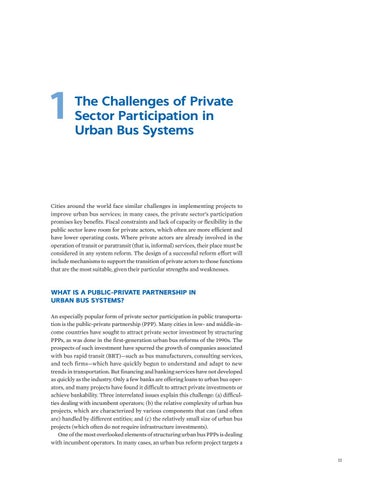1
The Challenges of Private Sector Participation in Urban Bus Systems
Cities around the world face similar challenges in implementing projects to improve urban bus services; in many cases, the private sector’s participation promises key benefits. Fiscal constraints and lack of capacity or flexibility in the public sector leave room for private actors, which often are more efficient and have lower operating costs. Where private actors are already involved in the operation of transit or paratransit (that is, informal) services, their place must be considered in any system reform. The design of a successful reform effort will include mechanisms to support the transition of private actors to those functions that are the most suitable, given their particular strengths and weaknesses.
WHAT IS A PUBLIC-PRIVATE PARTNERSHIP IN URBAN BUS SYSTEMS? An especially popular form of private sector participation in public transportation is the public-private partnership (PPP). Many cities in low- and middle-income countries have sought to attract private sector investment by structuring PPPs, as was done in the first-generation urban bus reforms of the 1990s. The prospects of such investment have spurred the growth of companies associated with bus rapid transit (BRT)—such as bus manufacturers, consulting services, and tech firms—which have quickly begun to understand and adapt to new trends in t ransportation. But financing and banking services have not developed as quickly as the industry. Only a few banks are offering loans to urban bus operators, and many projects have found it difficult to attract private investments or achieve bankability. Three interrelated issues explain this challenge: (a) difficulties dealing with incumbent operators; (b) the relative complexity of urban bus projects, which are characterized by various components that can (and often are) handled by different entities; and (c) the relatively small size of urban bus projects (which often do not require infrastructure investments). One of the most overlooked elements of structuring urban bus PPPs is dealing with incumbent operators. In many cases, an urban bus reform project targets a 11

